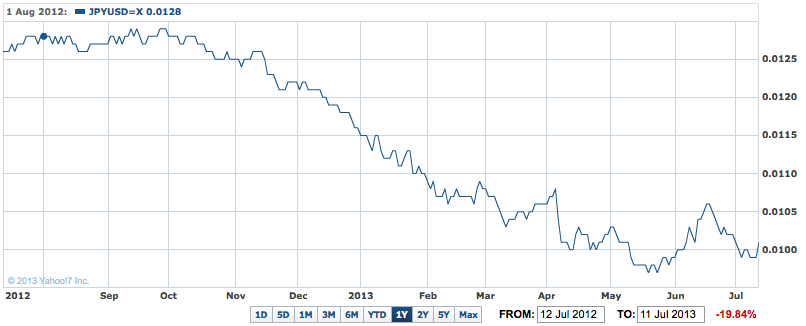Just as China’s economy continues to slow, raising concerns among Australian investors and companies about the health of our biggest export market, Japan, our number two market, seems to be going from strength to strength.
Yesterday the Bank of Japan, the country’s central bank, confirmed that the economy is looking and doing better by using the word ‘recover’ in its post meeting statement for the first time in two years.
That description came seven months after Prime MInister Abe’s government launched its plan to weaken the yen, boost inflation, spend more on infrastructure and start deregulating parts of the economy.
In April, the Bank of Japan started its radical plan to expand the country’s monetary base to try and break the hold deflation has on the economy by boosting inflation.
Both seem to be having an impact.
"Japan’s economy is expected to recover moderately on the back of the resilience in domestic demand and the pick-up in overseas economies.
The year-on-year rate of change in the CPI is likely to turn positive," the central bank said in its post meeting statement.
That is far more positive than anything the bank has been saying for the past two years of deflation, weak growth, recession and natural disasters.
It was the first time since early 2011 that the bank formally described the economy as being on an expansionary path, although Governor, Haruhiko Kuroda, has said he believes a recovery has begun.
In fact the bank’s official view of the economy has changed for the better over the past six months. Last month it said it saw a "pick-up" in exports and "resilience" in consumer spending. But yesterday’s statement was the first to identify a broad recovery in the economy.
Under Mr Kuroda, who took over as governor in March, the central bank has been pumping an unprecedented amount of money into the economy through increased purchases of government bonds.
The bank said yesterday that it would maintain its goal of expanding Japan’s monetary base at a rate of 60 to 70 trillion yen (around $A600 to $A750 billion a year.
JPYUSD 1Y – Weaker yen helping drag Japan into recovery mode

Figures out yesterday confirmed that the economy is doing better.
There was a sharp rise in machinery orders in May, up 10.5% compared with the previous month, significantly more than analysts had forecast. Although this is a very volatile series of statistics, it is nevertheless another bit of data (easing deflation, rising retail sales, improving exports) that points to the rosier economic outlook.
The bank said Business investment "has stopped weakening and shown some signs of picking up as corporate profits have improved.
"Public investment has continued to increase, and the pick-up in housing investment has become evident. Private consumption has remained resilient, assisted by the improvement in consumer sentiment.
"Reflecting these developments in demand both at home and abroad, industrial production is increasing moderately. Business sentiment has been improving. Meanwhile, financial conditions are accommodative. On the price front, the year-on-year rate of change in the consumer price index (CPI, all items less fresh food) is currently 0 percent. Some indicators suggest a rise in inflation expectations."
The while idea of the huge spending (quantitative easing) by the bank and a lift in stimulatory spending by the national government, has been to shake Japan free to the deflationary rut it has been in for most of the past 20 years.
So far it seems to be working. With elections for the Japanese Senate due later this month, the government of Prime Minister Abe may be in a position to start moving to other parts of his package of measures to boost the economy. These include more deregulation – which could still bring opposition from business and farm groups.
So what’s this mean for Australian exporters? Well, the first and main point is that Japan now seems to be changing for the better, and any lift in economic activity will translate into higher demand, which will boost imports from countries such as Australia.













